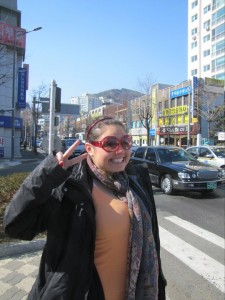Some of you wonderful readers hail from outside of Korea, and you might have wondered about how people get started teaching English in Korea. While providing the answers is beyond the scope of this blog, a couple of e-books are out there to help you learn the ropes. One of them, Coming to Korea, has been on my left sidebar for some time now. The author of a second recently contacted me through e-mail, offering a review copy for my perusal. I give you the Teach Korea Guide - the goal is “to help good teachers find great jobs in Korea.”
In the interest of keeping you informed, I’ll mention this up-front: Chris in South Korea received a review copy of each e-book, and is an affiliate for each. Since the two guides cover the same subject, I’ll tell you about them and let you make your mind up yourself.

The Coming to Korea Guide
Coming to Korea is put together by Valerie Stewart – she does the writing, while her husband Griffin handles the graphic design. This pair of English teachers based out of Ulsan. The first several pages spell out their to-good-to-be-true story: in their first two years in Korea, they made more money than most other couples in their position do.
Divided into ‘pros’ and ‘cons’, Coming to Korea focuses on the good and the bad – complete with vacation schedules. ‘The Life’ talks about their schedule and the activities available to teachers in Dae Han Min Guk. A real life schedule – complete with names – is on page 19. There are cons to coming to Korea, and Coming to Korea talks about them frankly. They spend a few pages talking about how teaching probably isn’t the dream job you might have expected it would be. They’re also quick to mention how those cons can be prevented at best, or deterred at worst.
The ‘advice’ chapter gives some practical advice – learn Korean, beware of ‘maybe’, get it in writing, and get involved. Some excellent anecdotal stories teach you what to look out for before you make the same mistake yourself. Trust me when I say avoiding one of the mistakes they made will be worth many times the cost of the e-book.
The ‘getting started’ chapter goes through the step-by-step process of getting a job teaching English, while the ‘tips and tricks’ chapter remind you of a few things you might want to know before heading to Korea. A recommended packing list, a link to some resources, and some recommended reading round out the e-book.
My biggest complaint here is how hagwon are made to look like the inferior choice. For better or worse, I’ve had no serious complaints with the hagwon I’ve worked for, and sort of wish they were put on the same level as public schools.
Coming to Korea is a 47 page e-book on sale for $9.97 – normally $14.97. The guarantee that comes with the book? Quoted from the website: “if you don’t feel like it has saved you at least 15 hours of online research or it would not help you avoid or anticipate at least five unpleasant surprises when coming to Korea, then let us know and we’ll buy it back from you.” You’re also buying access to the people – ask them questions via e-mail and they’ll offer personalized support.

The Teach Korea Guide
The Teach Korea Guide has been written by Lindsey Huster and Peterson Kuyk-White, two English teachers who came to Korea some time ago. Lindsey’s writings have appeared in the Groove Magazine and on Seoul Eats, while Peterson is a musician who also studied Korean drumming.
Step 1 – “make the decision” – is a short section on the benefits of coming to Korea, and the money available from teaching English in Korea. The case they make is fairly typical, although a gross one – there’s some talk of expenses, but not a lot. Seeing as how most people’s two biggest expenses (e.g. a place to live and transportation) are either non-existent or greatly reduced, this isn’t a huge omission.
Step 2 – “gather visa documents” – shows the process for a person from each country Korea takes English teachers from. Getting the visa is perhaps one of the most complex parts for most people, and this guide helps with the vast majority of it. It’s careful to note that people need to check with the official government sources – something virtually every legitimate guide is careful to say, considering how fast things change. This is the most extensive section in this short e-book.
Step 3 – “get a job” – the e-book does a good job on the pros and cons of public schools and hagwon. I wish there was a bit more detail, but perhaps it was left out in the interest of keeping things simple. The basics are all here – and there’s little need to venture to ESL Cafe for all their cynics.
Step 4 – “what we wish we had known before coming to Korea” – a couple’s perspectives on coming to Korea. If you’ve ever wanted to look through the eyes of experience, the pages here give you that look with a frankness not typically found in e-books.
At 34 pages, it’s surprisingly short – you’re paying for practical advice, not fluff. Any half-decent writer could fluff an e-book to be 200 pages long if they so chose; it takes a fair amount of skill to make your point in a book you can read in one sitting – or about 2 beers, if that’s the way you count. Included with the e-book are some checklists – perfect to ensure you get it all in that envelope across the world – and enough links of possible schools and places to post your resume to keep you busy for house. The Teach Korea guide is normally on sale for $14.95, but the first 50 copies will be sold at $9.95 – get a cheaper one while you can, if the book sounds interesting.
OK, so I have two e-books listed in my left sidebar, both dedicated to coming to Korea. Which one’s better? I’ve read them both, and they’re both helpful. Either is useful and easy to comprehend / follow. I wouldn’t put them on here otherwise. The former has a few design elements in place, while the latter is more tightly edited. Check them both out, then pick the one that looks better for you. If you’re coming to Korea, you don’t need me to tell you what to do every step of the way.
Author’s note: I’ve added these e-books to the left sidebar, as I feel they may be valuable to readers; the affiliate links might make me a few bucks if you buy it, but I wouldn’t recommend it if I didn’t think it was helpful. The trust I hope you have in this blog is worth far more than that.
 © Chris Backe – 2011
© Chris Backe – 2011
This post was originally published on my blog, Chris in South Korea. If you are reading this on another website and there is no linkback or credit given, you are reading an UNAUTHORIZED FEED.







 RSS Feed
RSS Feed














Recent comments